Cutting and Processing Meats
Poultry Cuts
Poultry refers to the edible flesh, with adhering bones, of any bird that is commonly used as food. Types of poultry include chickens, ducks, geese, turkey, quail, pheasant. All poultry is processed in a similar manner. It is either cooked whole or segmented in a number of ways depending on how it is to be used.
All segments of small, young poultry can be prepared using dry heat cooking methods. Older birds, once they stop laying eggs, are butchered and marketed as stewing hens or boiling fowl. These birds need moist heat preparation and are ideal for pot pies, stews, and soups. All poultry should be fully cooked to at least 74°C (165°F) to eliminate the presence of salmonella.
A bird can be split in half lengthwise through the backbones and keel bone, or it can be split into a front quarter and a hind quarter. The front quarter of the bird contains the breast and wing meats, while the hindquarter contains the legs. It is common to further break the poultry into segments.
For maximum yield and precise processing, poultry can be segmented by cutting through the soft natural joints of the bird. The term 8-cut chicken is used to describe a chicken segmented into two drumsticks, two thighs, and both breasts split in half across the rib bone (one half may contain the wing). This procedure is always done with the bone in. These segments can be processed further to boneless skinless cuts if desired. Figure 29 shows a fully segmented frying chicken, and Table 37 lists the common chicken cuts.
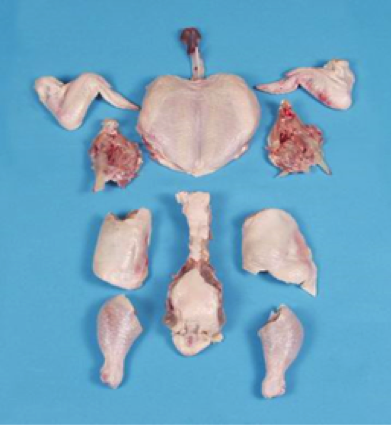
| Cut | Retail Cuts | Restaurant Cuts |
| Chicken breast | Chicken breastbone in | Suprême (chicken breast with wing drumette attached) |
| Chicken breast boneless/skinless | ||
| Chicken breast fillets (or tenders) | ||
| Chicken leg | Chicken leg (back attached) | Chicken Ballotine (boneless leg) |
| Chicken drumstick | ||
| Chicken thigh (bone in) | ||
| Chicken thigh (boneless skinless) | ||
| Chicken wing | Chicken wing (whole) | Chicken wings split, tips removed |
| Chicken winglette (or wingette) | ||
| Chicken wing drumette | ||
| Chicken wing tip | ||
| Backs and Necks | Chicken backs and necks | Chicken ribs, backs and necks are used for stock |
White Meat Cuts
White or light meat comes from the breast and wings. The breast and wings are generally separated, but a chicken breast with the drumette portion of the wing still attached is called a suprême. Wings can be broken down into three parts: wing tip, winglette, and wing drumette (Figure 30).
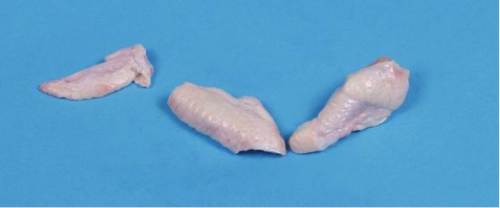
The breast can also be broken down further and the tenderloins (fillets) removed. The portion without the tenderloin can be split and pounded into a thin cutlet known as a paillard. Figure 31 shows the chicken breast whole and with the fillets removed from the bottom portion.
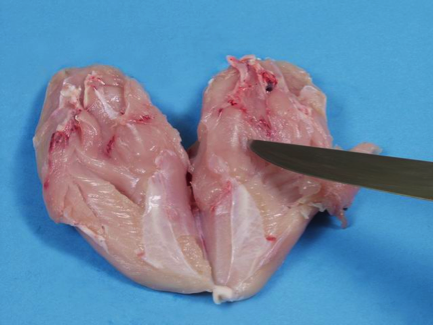
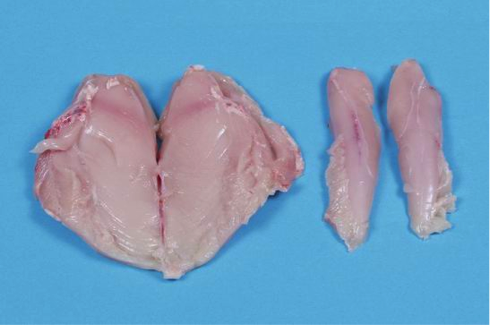
Dark Meat Cuts
The dark meat of poultry comes from the legs, which can be broken down into two parts: the thigh and the drumstick. In restaurants, you may occasionally find a boneless leg that has been stuffed, which is called a ballotine.
Chicken legs are split at the knee joint to separate the thigh from the drumstick. Drumsticks are usually cooked bone in, while thighs can be deboned and skinned to use in a variety of dishes, including slicing or dicing for stir-frys and similar dishes.
Figure 32 shows a whole chicken leg broken down into a drumstick and boneless thigh.
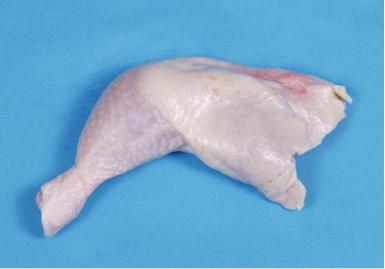

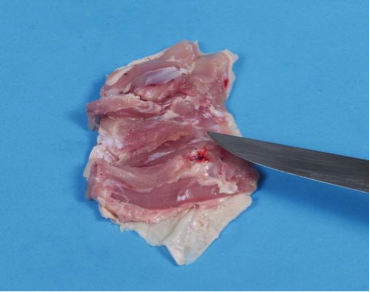
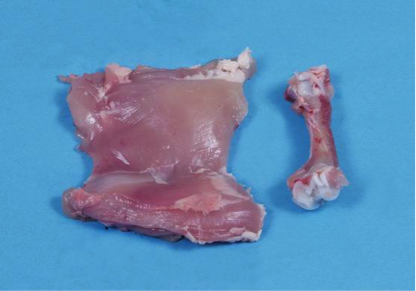
Media Attributions
- Segmented frying chicken © TRU Meatcutting Department is licensed under a CC BY-NC (Attribution NonCommercial) license
- Segmented chicken wing © Jakes and Associates
- Chicken breast whole © Jake and Associates is licensed under a CC BY-NC (Attribution NonCommercial) license
- Boneless skinless chicken breast with fillets removed © Jakes and Associates is licensed under a CC BY-NC (Attribution NonCommercial) license
- A whole chicken leg © Jakes and Associates is licensed under a CC BY-NC (Attribution NonCommercial) license
- A drumstick © Jakes and Associates is licensed under a CC BY-NC (Attribution NonCommercial) license
- Chicken thigh with skin and bone © Jakes and Associates is licensed under a CC BY-NC (Attribution NonCommercial) license
- Skinless, boneless chicken thigh © Jakes and Associates is licensed under a CC BY-NC (Attribution NonCommercial) license
Any of a variety of birds raised commercially for food.
Breast of poultry with the wing bone attached.
Boneless chicken tenderloin.
A boneless chicken breast that has been pounded flat.
A stuffed boneless chicken leg.

